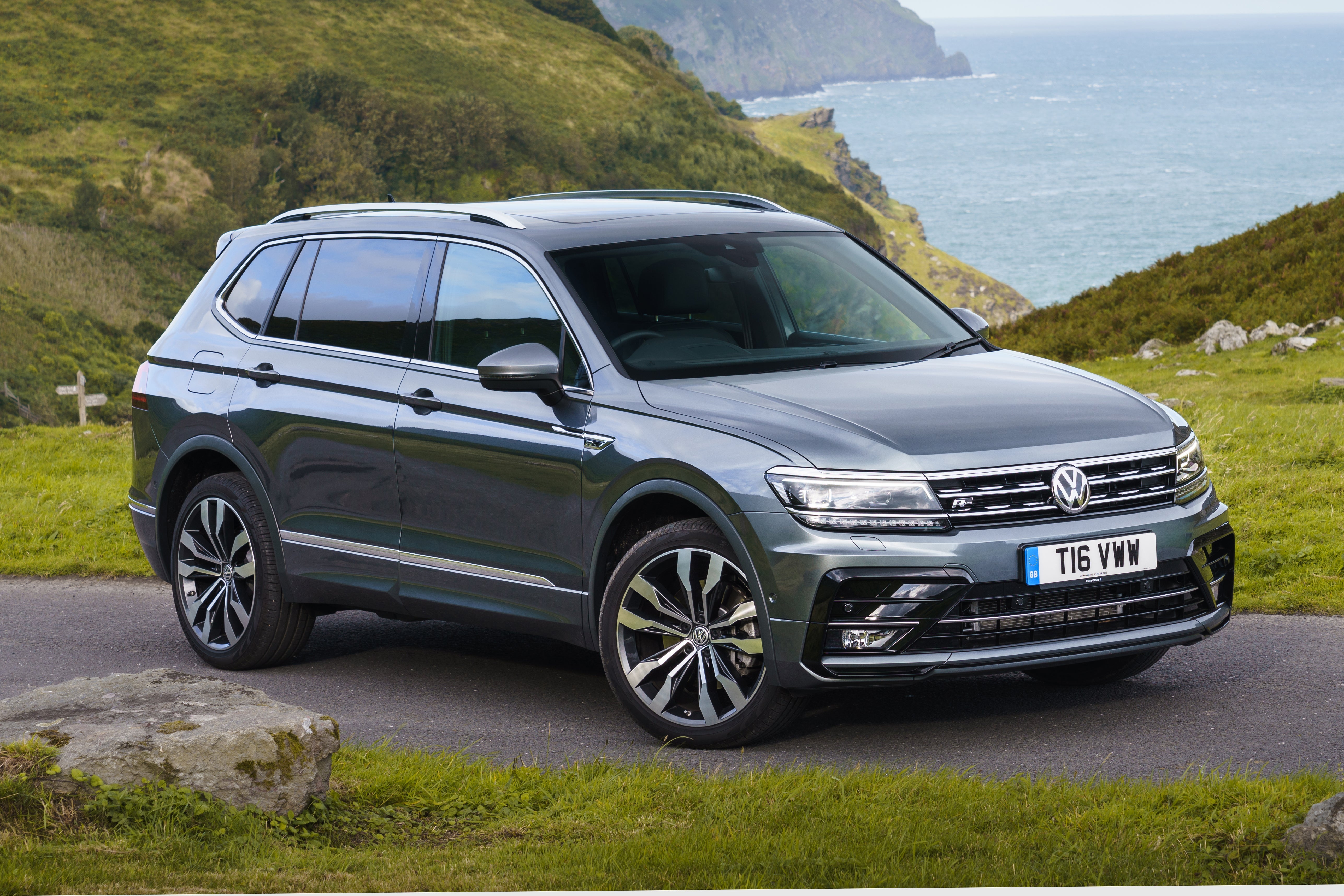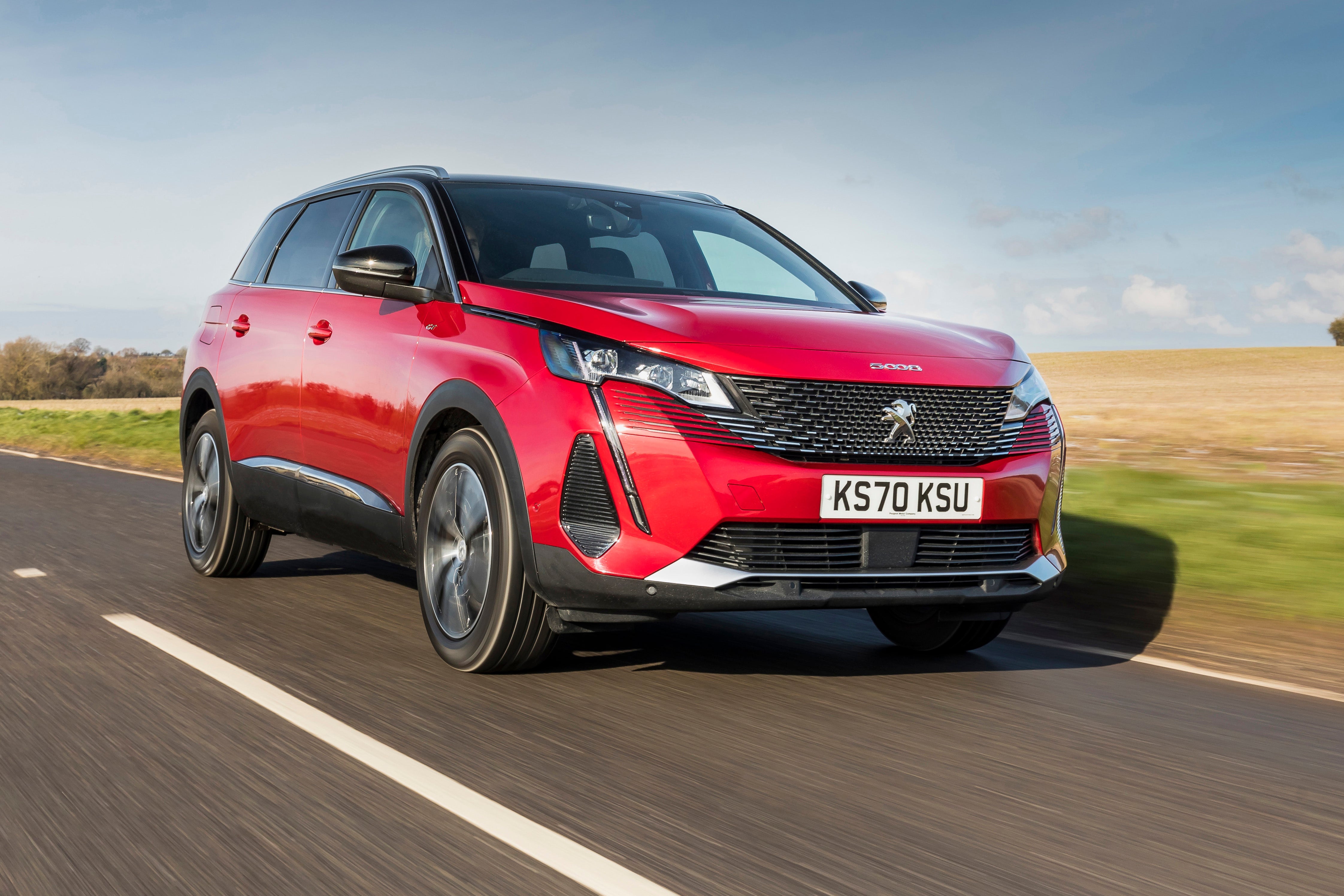Skoda Kodiaq vRS Review 2023
Written by Andrew Brady
Quick overview
Pros
- Good savings available on nearly-new models
- Effortless performance from powerful engine
- Spacious interior for all the family
Cons
- Third row of seats for occasional use only
- Not as fun as you might expect
- Surprisingly extensive options list for a pricey SUV
Overall verdict on the 2022 Skoda Kodiaq vRS
"In this Skoda Kodiaq vRS review we're looking at something of a novelty act. Skoda performance vRS brand is well established, but this is the first time it's been applied to one of its SUVs, even more remarkable because it's a seven-seater - there are few cars that can seat seven and offer a real turn of speed. That reflects the fact not many buyers want that combination, but if you do, then the Skoda Kodiaq vRS is practical and fun, if pricey and somewhat compromised."
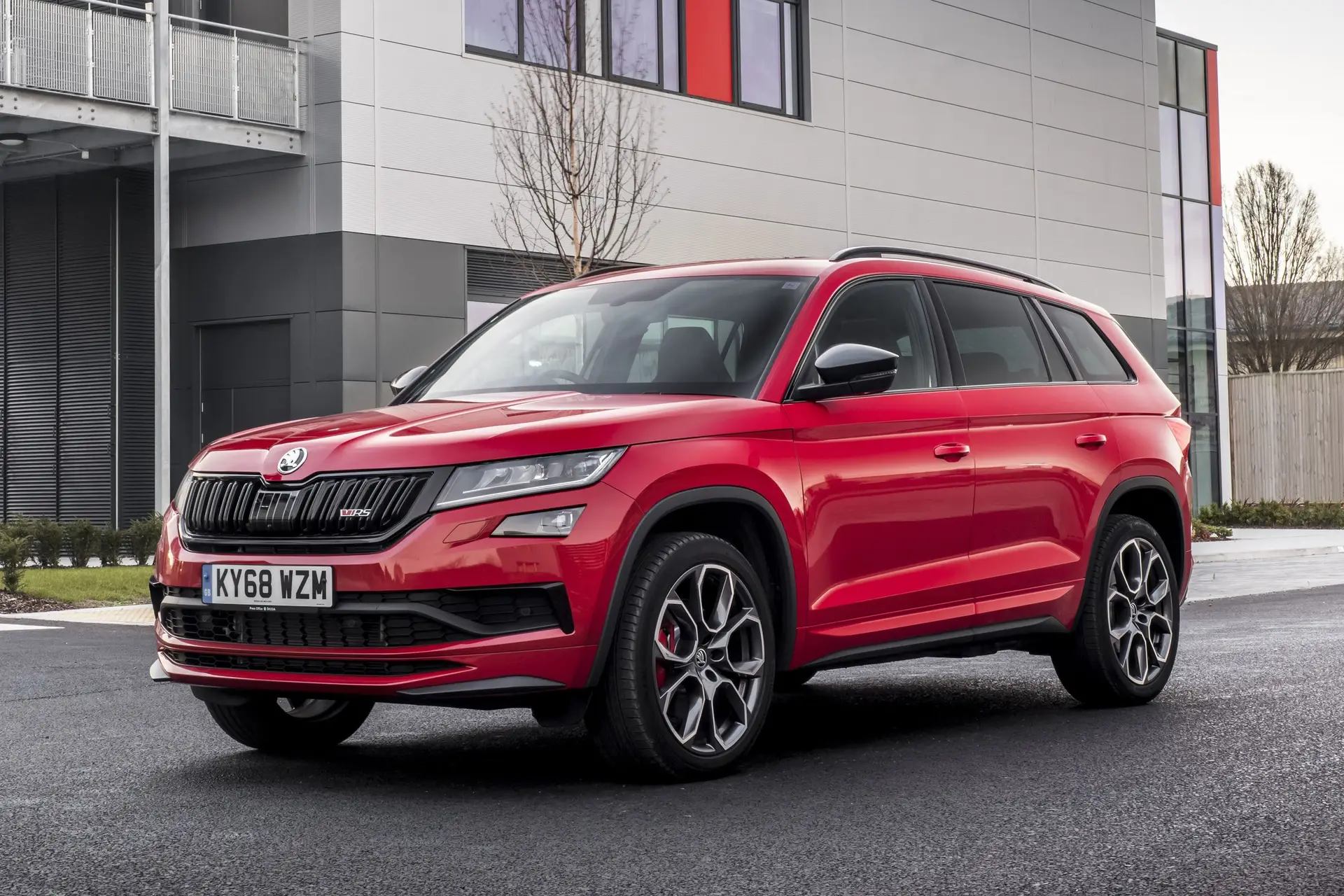
Not ready to grow up and buy a sensible SUV? The Skoda Kodiaq vRS is the car for those of us who need seven seats for taking the kids to ballet practice, yet long for a hot hatch like the Volkswagen Golf GTI.
On the face of it, there probably isn’t a greater all-rounder on sale than the Skoda Kodiaq vRS. It’s just as versatile and comfortable as the regular Skoda Kodiaq, yet Skoda’s given it a significant sporting bent over the standard car. Power comes from a turbocharged 2.0-litre petrol engine that will help it towards 62mph in 6.4 seconds, while a very useful 370Nm of torque means it’s quite an effortless car to drive quickly.
The suspension’s been reworked, with adaptive dampers letting you decide how firm you’d like the Skoda Kodiaq vRS's ride to be. Surprisingly, even with 20-inch alloy wheels, it’s a fairly compliant and comfortable car on a broken road.
It’s not as fun to drive as the smaller Volkswagen T-Roc R or Cupra Ateca, though. Both are smaller, lighter and more agile than the Skoda Kodiaq vRS and you’ll only see low-30s MPG at a push alongside some hefty tax bills. But what do you expect from a performance SUV that costs well over £40,000 when new?
And it’s not all bad news - even though the Skoda Kodiaq vRS sells in tiny numbers compared to the standard car, there are some excellent nearly-new deals to be had. We’ve seen dealers offering up to £8,000 off the list price, which turns the hot Kodiaq into a much more tempting proposition.
You might think that a top-spec Skoda Kodiaq vRS will be absolutely loaded with kit, and standard equipment includes a fancy 9.2-inch navigation system and the on-trend virtual dials. But there’s also an extensive options list.
Still, the interior feels well made and we like the sporty touches like a carbon-effect dash and aluminium pedals (even if they do look a bit aftermarket). The seats are particularly cool, with figure-hugging bolsters and stylish diamond stitching - but they’re also very comfortable, with plenty of adjustment making it easy to find a good (albeit rather high) seating position.
Many buyers will find one of the lower-spec Kodiaq models will suit their needs better. But as an all-rounder, a car that can transport the family while also being fun to drive and feeling premium, the Skoda Kodiaq vRS is a strong choice.
If you are looking for the regular version, you can check out our Skoda Kodiaq Review (2022).
Is the Skoda Kodiaq vRS right for you?
The Skoda Kodiaq vRS won’t suit everyone. If you’re looking for an SUV that’s hilarious to drive, we’d suggest the smaller Cupra Ateca could be a better buy. If you do need a practical SUV, you can save a lot of money by looking for one of the more affordable Kodiaq models. The Scout, for example, is a more relaxed (and frugal) car available with a potent-enough 190PS diesel engine.
Still, if you want a stylish SUV that’s big enough to squeeze seven people (at a push) while still being fun to drive and without breaking the bank, the Skoda Kodiaq vRS should be on your shortlist.
What’s the best Skoda Kodiaq vRS model/engine to choose?
Skoda initially offered the Skoda Kodiaq vRS with a 2.0-litre bi-turbo diesel engine, which wasn't as quick but offered more torque and slightly better fuel consumption. With the general turn against diesel power, in 2021 Skoda dropped the diesel and offered it solely with the 2.0-litre petrol engine and seven-speed DSG gearbox.
What other cars are similar to the Skoda Kodiaq vRS?
While the Skoda Kodiaq vRS makes a big deal out of its sportiness, the closely-related Volkswagen Tiguan Allspace is available with the same engine for similar money. It’s classier and more understated than the Skoda Kodiaq vRS, in our opinion, and it’s even slightly quicker. Most buyers would prefer the Volkswagen badge, too.
Alternatively, you could also look at the Cupra Ateca, comfortable Volkswagen T-Roc R or Audi SQ2, but these are all smaller and petrol-powered. The Kodiaq isn’t far price-wise from more premium alternatives like the Land Rover Discovery Sport, either.
Comfort and design: Skoda Kodiaq vRS interior
"We really like the standard Skoda Kodiaq interior, while the vRS adds a number of sporting touches to make it feel that bit more special."
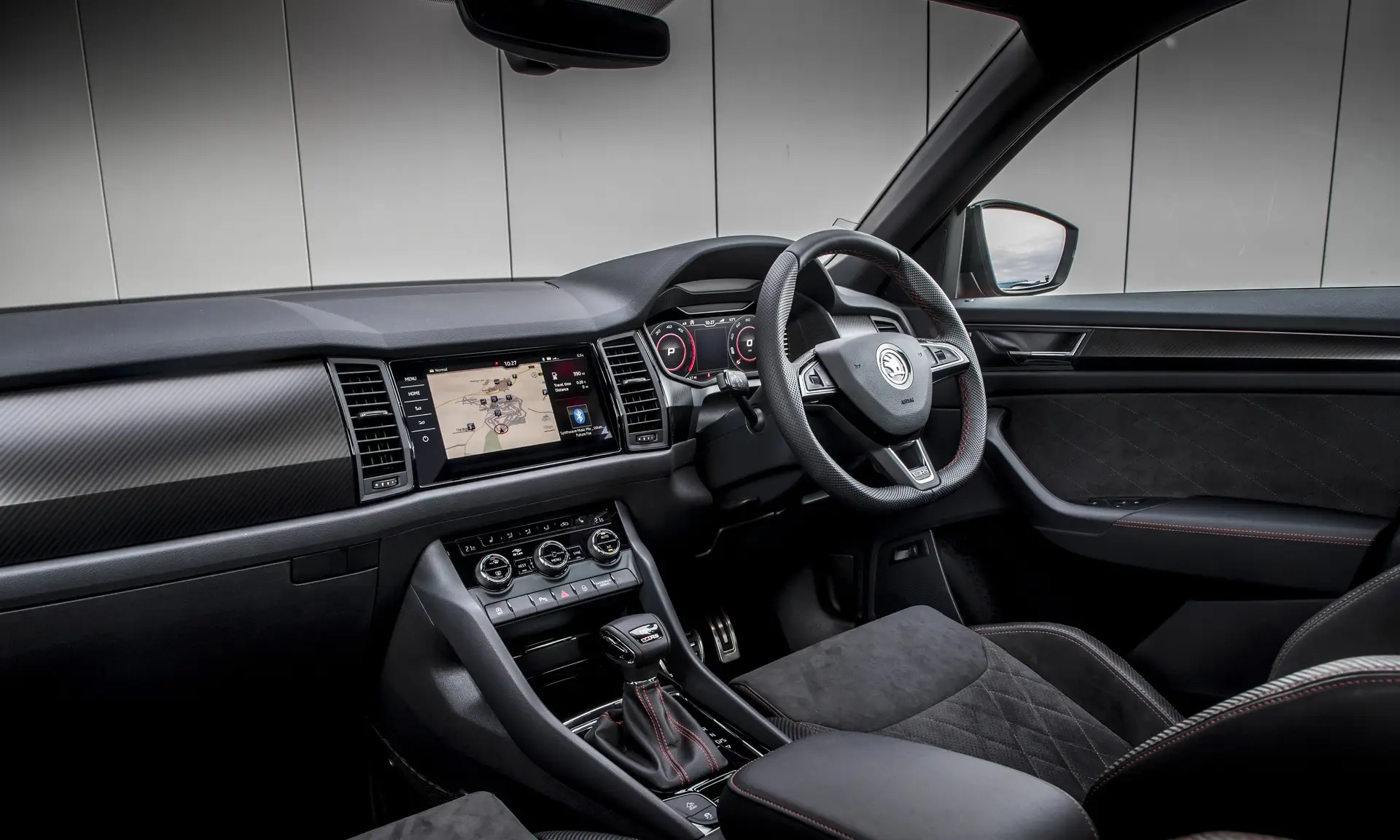
The front sport seats look the part, with red diamond stitching and big, figure-hugging side bolsters to hold you in place during sporty driving. They might look like they’ve been lifted from a race car, but they’re surprisingly comfortable. The driver’s seat features electric adjustment, too, with adjustable lumbar support - a desirable feature on a long journey. Would it be too much to expect electric seat adjustment on the front passenger seat, too?
Even with plenty of adjustment, the seats are positioned fairly high up. This gives you the ability to look down on inferior cars and enjoy a good view over hedgerows, but it doesn’t feel particularly sporty. You’re certainly not ‘as one’ with the road like you’d be with a focussed hot hatch.
Other highlights of the Skoda Kodiaq vRS’s cabin include a carbon finish dashboard which looks pretty sporty although, secretly, we think we prefer the Scout’s wooden dash. There’s a smattering of vRS badges and aluminium pedals, although these look a little aftermarket to us.
There are a few handy optional extras which you might wish to look out for to make the cabin that little more luxurious. Heated front and rear seats are a £215 option when new, while the £325 sleep package comes with a more comfortable headrest on the second row of seats, mechanical sun blinds and acoustic side glass.
Quality and finish
The Skoda Kodiaq’'s cabin is a classy affair - and that’s especially true for high-spec models like the range-topping vRS. It might not be quite as premium as the Audi SQ2, but it’s significantly plusher than a Cupra Ateca or Volkswagen T-Roc R.
Everything you touch feels well-finished, with even the buttons and switchgear giving off a premium vibe. You get a meaty, thick-rimmed steering wheel wrapped in leather and stylish microsuede seats with contrasting red stitching.
Not only does the sporty Skoda Kodiaq’s interior feel upmarket, but it also appears extremely well made. We’re sure it’ll do a good job of deflecting abuse from even the clumsiest of families.
Infotainment: Touchscreen, USB, nav and stereo in the Skoda Kodiaq vRS
The biggest and best infotainment system available in the Kodiaq is offered as standard in the vRS. It’s the 9.2-inch Columbus navigation system, which provides sharp graphics and quick responses to pinch and swipe finger gestures.
While it’s very good on its own, you can use Apple CarPlay and Android Auto to mirror apps from your phone onto the display. This is great if you’d prefer to use third-party navigation apps like Google Maps or Waze, or if you wish to access your podcasts and music playlists. WiFi is integrated, too, so your passengers won’t have to drain all their phone data on a long journey.
Also standard is the 10.25-inch virtual cockpit, which replaces the conventional dials behind the steering wheel. This is a really desirable system which contributes to the cabin feeling more upmarket than you’d expect for a Skoda. It’s not as distracting as you might expect, either, and drivers can select from a number of different displays.
Audiophiles may wish to look for a Kodiaq with the optional Canton sound system. This uses 10 speakers dotted around the cabin to provide a clear sound, but it’s a £420 option when new.
Space and practicality: Skoda Kodiaq vRS boot space
The Skoda Kodiaq vRS is only sold as a seven-seater in the UK, but don’t go expecting to use all its seven seats all of the time. It might be a big car, but you’d be better looking for a sensible people carrier like the SEAT Alhambra if you actually want to carry seven people regularly.
The third row of seats are in the boot and are difficult to access, although kids will embrace the challenge. Teenagers will find them cramped and uncomfortable for longer journeys, though, and then there’s the small matter of where the luggage is going to go.
With all the seats in use, there are just 230 litres left for stuff. There’s more space in the back of a Skoda Citigo. Still, they drop to provide an entirely flat boot floor and a more generous 630-litre luggage capacity.
Access to the middle seats is easy, and there’s a generous amount of head and legroom back there. You can recline the individual rear seats, which is a nice touch, and the entire bench slides back and forth so you can prioritise where space is needed the most. The outer rear seats are fitted with ISOFIX child seat mounting points, but you’re going to struggle to squeeze three young children side-by-side.
If you have got three young children to carry, look for a Skoda Kodiaq vRS with the optional ISOFIX mounting points on the front passenger seat.
In the front, there’s loads of room. You sit fairly high up, giving you a good view of the road ahead, but even tall drivers won’t find headroom an issue. There’s plentiful legroom, while there’s also a handy amount of storage space. You’ll find a cubby under the middle armrest, big door bins and somewhere to rest your phone in front of the gear lever.
The Skoda Kodiaq vRS dimensions are 4699mm long, 2087mm wide and 1665mm tall.
Handling and ride quality: What is the Skoda Kodiaq vRS like to drive?
"If you’re expecting to chuck the Skoda Kodiaq vRS around like a hot hatch, you might be disappointed. This is a two-tonne family SUV and, even with all the will in the world, you’re not going to keep up with a Porsche Macan on a race track."
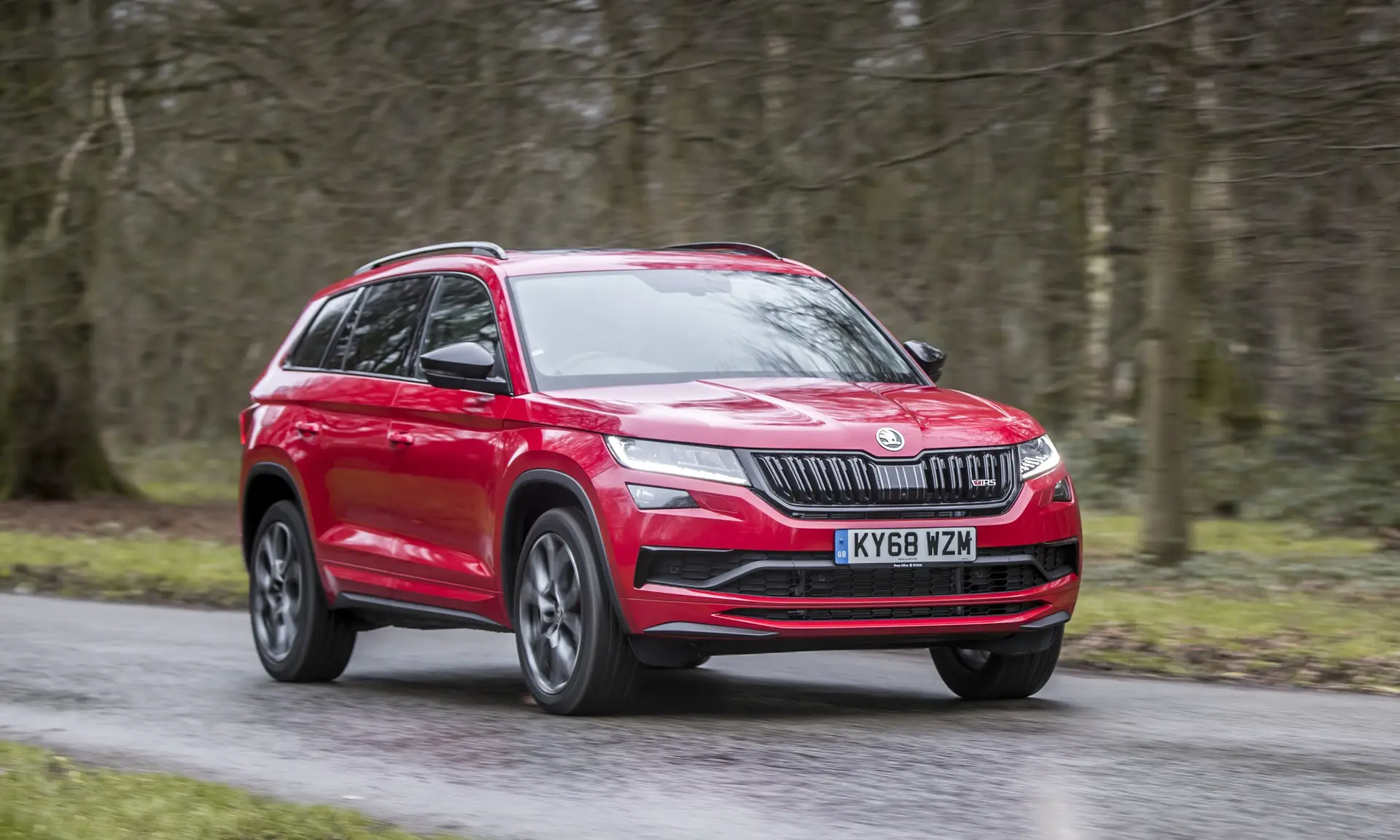
Skoda’s chucked everything at the Skoda Kodiaq vRS to make it feel a bit more special than a standard car, however. You get meaty disc brakes all around, big wheels with wide tyres, and Skoda’s Dynamic Chassis Control (DCC). This lets you use the drive modes to firm up the suspension when you’re in the mood.
It’s certainly more agile than the standard Skoda Kodiaq, helped by progressive steering which requires smaller inputs at higher speeds. There’s also an intelligent four-wheel-drive system which can shift up to 85% of torque to any given wheel in a fraction of a second. You can’t really feel it moving power about, but it’s fair to say there’s an enormous amount of grip available.
Ultimately, though, if you’re after B-road thrills, you’d be better with the smaller Volkswagen T-Roc R or Cupra Ateca. Or buy a standard Kodiaq and spend the remaining cash on a Mazda MX-5.
Surprisingly, despite its big wheels and trick suspension, the Skoda Kodiaq vRS remains fairly composed on bumpy roads. Sure, the softer DCC settings will become your friend if you’re looking to travel in comfort, but a rogue pothole isn’t going to catch you out as much as you might expect.
What engines and gearboxes are available in the Skoda Kodiaq vRS?
You might expect a sporty SUV like this to be hiding a powerful petrol engine under the bonnet. The small Cupra Ateca, for example, uses a 300PS turbocharged 2.0-litre unit.
However, the Skoda Kodiaq vRS ‘makes do’ with a 245PS 2.0-litre petrol paired with a DSG automatic gearbox. It’s powerful enough on paper, but it doesn’t feel super quick in reality. It’ll accelerate to 62mph in 6.4 seconds flat, which is going to be quick enough for joining a motorway or overtaking a dawdling Honda Jazz. It’s a big, heavy SUV though, and it’s not going to defy physics.
There’s a useful 370Nm of torque which means it’ll effortlessly build speed when required, but it is hindered slightly by its standard DSG automatic gearbox. The seven-speed transmission can be a little hesitant to respond, especially from a standstill. You can get paddles behind the steering wheel to take control of the gearbox but it’s still not as involving as a manual gearbox.
Refinement and noise levels
The standard Kodiaq is a very refined choice - so you’d expect the range-topping model to be even more civilised, right? Except, this is sporting the vRS badge. Even though it’s powered by a 2.0-litre petrol engine, Skoda’s attempted to make it sound like a V8 muscle car.
Under acceleration, you’ll hear a distinct engine noise that sounds nothing like a modern 2.0-litre petrol. That’s because it’s got a Dynamic Sound Boost feature, which essentially uses a speaker to mimic the sound of something throatier and remind passengers that they’re in a sportier-than-average Kodiaq.
Settle into a cruise and it’s a refined enough SUV. You’ll notice a bit more road noise from the rumble of the 20-inch alloy wheels, but wind noise is pretty well hushed. You’re not going to notice any serious vibration through the controls and the Kodiaq isn’t too focussed to use as a family car. That’s a good thing for a seven-seat SUV.
Safety equipment: How safe is the Skoda Kodiaq vRS?
While there’s a whole host of clever safety equipment available on the Skoda Kodiaq vRS, it’s surprising (and a bit disappointing) how much of it will cost the original buyer extra rather than it being included as standard. This is an SUV that costs more than £48,000 new so we can’t help but feel that Skoda’s been a bit stingy with its standard equipment.
As an example, Skoda offers a driver alert system with a fatigue sensor. This monitors your behaviour and alert you to stop when required. It’s a useful safety feature - but who’s going to pay £50 for the car to tell them to stop for a coffee?
A lot of the most useful features are lumped together as part of the driver assistance package. This costs £1,075 on a new Skoda Kodiaq vRS and is worth looking out for on the used market. Highlights include the lane assist - which nudges your steering if you start to stray from your lane - and rear traffic alert, which’ll let you know of approaching vehicles when backing out of a space. It also adds blind-spot detection and traffic jam assist, as well as adaptive cruise control.
The Kodiaq comes with ISOFIX child-seat mounting points as standard on the outer rear seats. If you want to fit one to the front passenger seat, look for one with option box ticked to have them fitted here too. It’s an extra £45 when new.
Trick crash-prevention technology aside, the Kodiaq scored a solid five stars (out of five) when it was crash tested by Euro NCAP in 2017. It’s fundamentally a very safe choice for transporting your family.
MPG and fuel costs: What does a Skoda Kodiaq vRS cost to run?
"Officially, the Skoda Kodiaq vRS returns up to 32.4mpg in combined WLTP fuel economy tests."
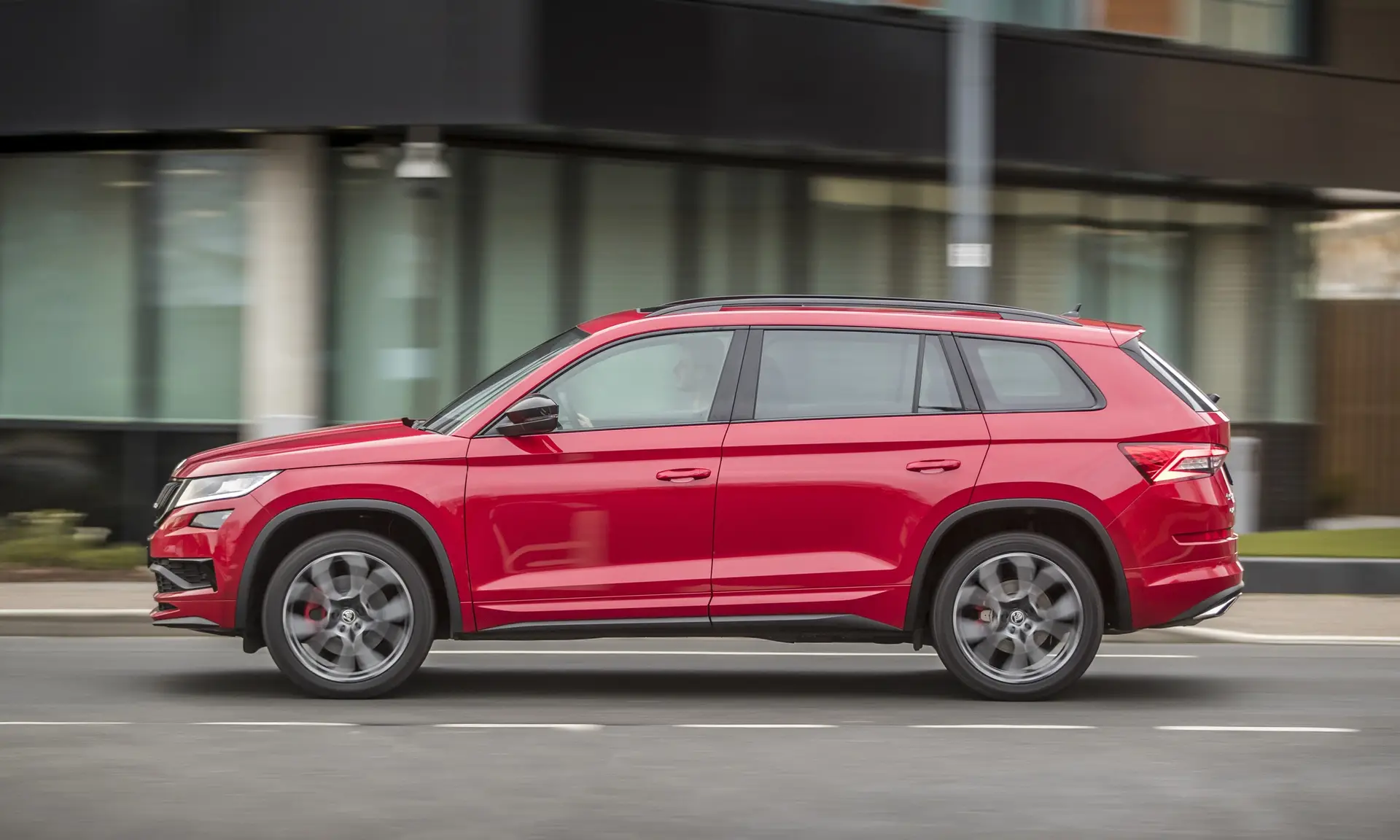
That means you should be able to see fairly close to this figure in the real world but only if you go very steady.
How reliable is a Skoda Kodiaq vRS?
The Skoda Kodiaq scored an impressive 9.61 out of 10 for reliability in the HonestJohn.co.uk Satisfaction Survey, and although this is for all versions of the Kodiaq rather than just the vRS, you can expect it to perform similarly well.
As a brand Skoda did equally well, finishing 6th overall out of 30 manufacturers, which suggests that Skoda owners are very happy with most aspects of their cars.
Insurance groups and costs
The Skoda Kodiaq vRS is going to be quite an expensive car to insure, particularly if you’re a young or inexperienced driver. It’s placed in insurance group 31, making it (unsurprisingly) the costliest Kodiaq you can insure. Still, the smaller Cupra Ateca falls into insurance group 33 - so it could be worse. We’d always recommend shopping around for quotes, anyway.
VED car tax: What is the annual road tax on a Skoda Kodiaq vRS?
Unfortunately, you’re going to have to splash the cash on road tax. All petrol and diesel cars registered since April 2017 are subject to a flat rate of £165 a year in tax. On top of that, premium cars (with a list price of more than £40,000), are charged a ‘premium tax’ of an extra £355 a year for five years (from the second year onwards).
That means - even if you don’t pay more than £40,000 for a Skoda Kodiaq vRS - you’ll have to pay £520 a year in tax.
How much should you be paying for a used Skoda Kodiaq vRS?
"A budget of around £30,000 will get you a into the earliest version of the Skoda Kodiaq vRS, which means diesel-only."
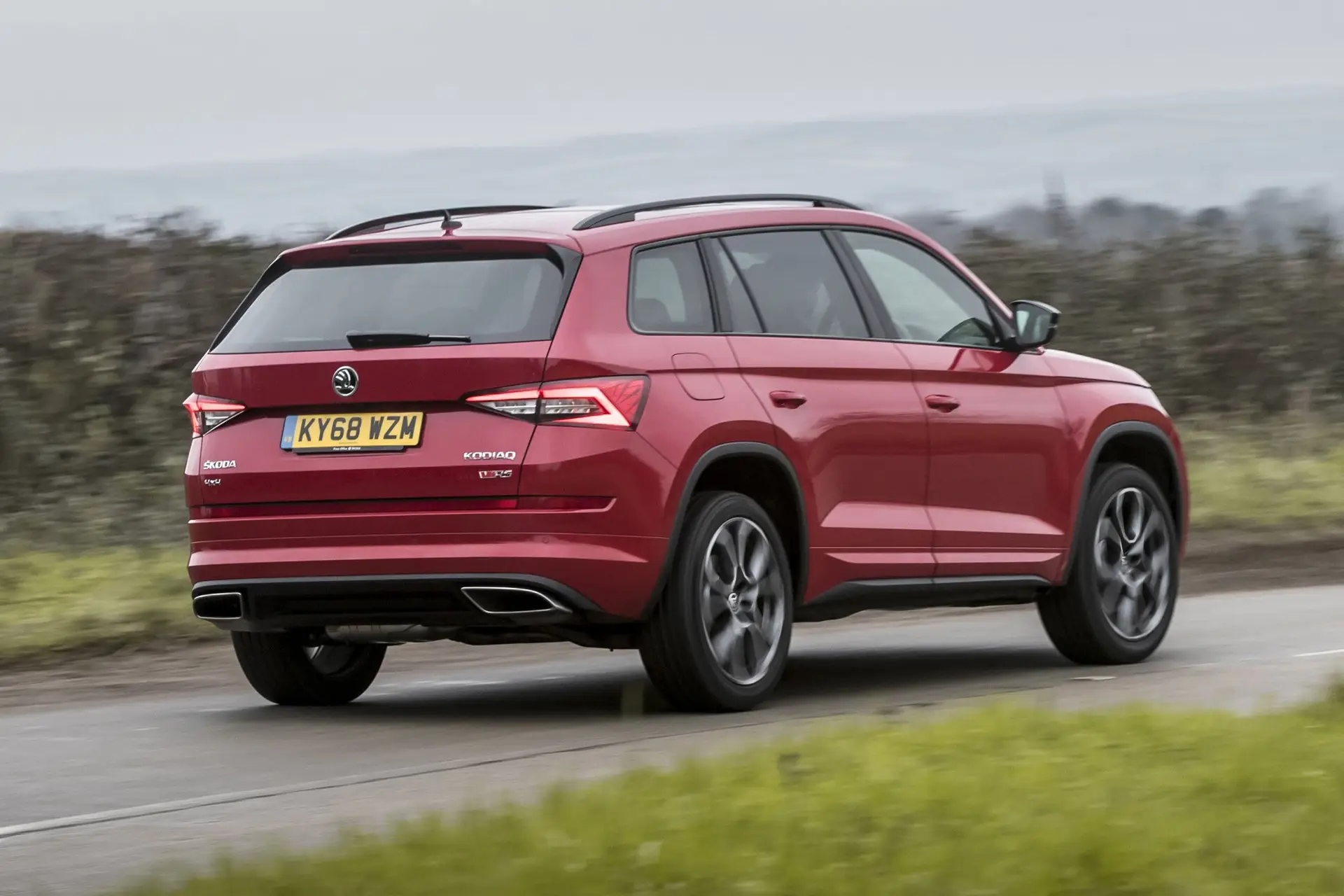
Because the petrol version only appeared in 2021 there are even fewer examples around. However, we found a 2021 petrol vRS with only 15,000 miles for £41,000, which is a decent saving on list price.
Trim levels and standard equipment
The Skoda Kodiaq vRS tops the standard Kodiaq range, meaning it’s loaded with kit. Its extensive equipment list includes 20-inch alloy wheels, bespoke front and rear bumpers, black exterior highlights and dual exhaust pipes. Metallic paint is included, while front and rear LED lights are also standard.
Inside, you’ll find Alcantara sports seats with red stitching and vRS logos. They’re heated in the front, while the driver’s seat gets electric adjustment with adjustable lumbar support. All Skoda Kodiaq vRS models come with the 9.2-inch Columbus navigation system as well as the Virtual Cockpit.
Front and rear parking sensors are included, as well as Dynamic Chassis Control. You’ll find Isofix child seat fittings on the outer rear seats, while a tyre repair kit replaces the conventional spare wheel.
Despite all this standard equipment, there are quite a few desirable optional extras to look out for. These include a heated windscreen (£310 on a new Skoda Kodiaq vRS), adaptive cruise control (also £310) and a panoramic sunroof (£1205). Park assist will help you tackle a tight parking space (£330), while a rear-view camera is a useful option (£395).
If you cover lots of miles, it might be worth looking for one with the £1,075 driver assistance package. This brings with it lane assist, blind-spot detection, traffic jam assist, rear traffic alert, emergency assist and adaptive cruise control.
Ask the heycar experts: common questions
Why is the Skoda Kodiaq discontinued?
What Skodas are vRS?
Which Skoda Kodiaq is the top of the range?
Stay up to speed with great offers plus the latest car news and reviews
Keep me updated by email with the latest advice, news and offers from heycar.
By submitting you agree to our privacy policy

